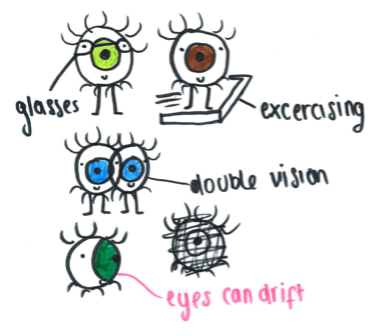By Vijay Tailor-Hamblin,
This session was super busy as we had 5 researchers (more than usual) and although it was slightly rushed, I think I learnt lots of new information about research and eye conditions.
The first study we heard about was Michael Crossland’s study, which was very interesting. He is trying to figure out if the amount of sleep we get affects our vision and if it can make eye conditions worse. Right now, most researchers think it doesn’t really make a difference but there is lots of evidence to say it does. Some YPAG members said that they have seen a difference themselves in their vision after a bad night’s sleep. I thought this was funny because many parents say that sleep is really important and maybe it’s true about vision too.
Dipesh Patel’s research study on amblyopia and patching in young children resonated with YPAG members, many of whom actually had to have a patch growing up, so I hope we were able to make good contributions to this research. What Dipesh wanted to know was how can we make sure children actually wear their patches and why might they not want to. There are many reasons such as reactions from other children and the fact that lots of teachers in school simply don’t care if they remove their patch. We tried to brainstorm ideas that would make children more confident in their patch such as more fun designs and rewards. I think this study is very important for lots of children with amblyopia to help improve their vision in their weaker eye.
Third we talked to Maria Theodorou about nystagmus, which is a condition where there is continuous movement of the eye (wobbly eye). We helped Maria to understand what questions could be asked to understand the eye condition in young people. We also made suggestions about who should deliver these questionnaires and whether our parents and careers should be there or not.
 After, we talked to Vijay Tailor (our eyeYPAG facilitator) about intermittent divergent squints which sounds very complicated but really, it’s quite simple – it involves one or both of the eyes drifting in different directions. It causes double vision and eye strain. However, there are some ways to improve it; these include eye
After, we talked to Vijay Tailor (our eyeYPAG facilitator) about intermittent divergent squints which sounds very complicated but really, it’s quite simple – it involves one or both of the eyes drifting in different directions. It causes double vision and eye strain. However, there are some ways to improve it; these include eye  exercises and surgery. In this session, we drew some pictures on how to represent these symptoms and their cures (in my opinion, my drawings were the best). I think this was really fun as I love to draw, and I had never heard of this disease, and I now know a lot about it.
exercises and surgery. In this session, we drew some pictures on how to represent these symptoms and their cures (in my opinion, my drawings were the best). I think this was really fun as I love to draw, and I had never heard of this disease, and I now know a lot about it.
Last but not least, we talked to Annegret (Professor Annegret Dahlmann-Noor) about her research involving myopia and if spending time outside can help cure it. I found this really interesting as we found out that, in natural light, there is much more red light than in artificial light. What Annegret wants to find out is: are there more young people with myopia in big cities where schools have less outdoor space and children are inside more often? We have talked about how red light can help myopia before at the eyeYPAG so I was interested to find out more about this. In this study, Annegret wants to find schools with lots of outdoor learning spaces and others with less outdoor space so she and her team can test the students. We also helped Annegret with these tests to make them more accessible to kids and made suggestions about how they could be improved.
I really enjoyed this session because I just learnt so much and I think everyone that was there would agree. I really liked having more researchers than usual – although there was so much information to take in, I think I was able to absorb lots of information and facts that I’d never even considered before around the different types of vision conditions.